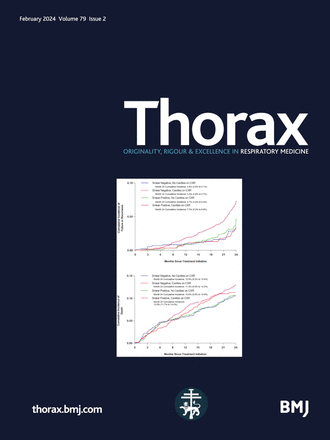高收入国家和中低收入国家学龄儿童特应性和非特应性哮喘的危险因素
IF 7.7
1区 医学
Q1 RESPIRATORY SYSTEM
引用次数: 0
摘要
众所周知,存在不同的哮喘表型,但尽管对特应性哮喘(AA)的决定因素进行了很好的研究,但对非特应性哮喘(NAA)知之甚少。我们比较了各国儿童特应性、特应性AA和非特应性NAA的危险因素。方法采用来自23个国家的4项研究,我们评估了6-17岁儿童的哮喘状况和特应性(皮肤点刺试验),以及来自住房、供暖、宠物、家庭、饮食和空气质量类别的危险因素。使用混合效应logistic回归模型,我们评估了四个途径的危险因素:途径1 -非特应性非哮喘到NAA;途径2 -非特应性非哮喘到特应性(无哮喘);途径3 -特应性非哮喘到AA;途径4 -非特应性非哮喘到AA。我们使用Pearson相关系数(PCC)比较不同途径间危险因素的对数赔率。结果32 741例患儿中,67%既无特应性也无哮喘,15%有特应性但无哮喘,8%有AA, 10%有NAA。途径1和途径3的危险因素相似(PCC=0.81, 95% CI 0.68 ~ 0.94)。相反,途径2和途径3的危险因素不同(PCC= - 0.06, 95% CI - 0.29 ~ 0.17)。这些发现表明,尽管特应性增加了哮喘的风险,但随后发生哮喘的危险因素在有特应性和没有特应性的人群中通常是相同的。这提出了关于特应性在哮喘中的作用的重要问题,特别是它是病因学过程的固有部分还是巧合。数据可以在一个公共的、开放访问的存储库中获得。如有合理要求,可提供资料。数据可能会从第三方获得,并且不会公开提供。ISAAC数据可在英国数据服务档案馆()公开获取。向ALSPAC执行团队提出申请后,可以访问ALSPAC数据;应用说明和数据使用协议可在[http://www.bristol.ac.uk/alspac/researchers/access/][1]]获得。WASP和SCAALA研究的相关数据将在合理要求下分享给通讯作者。[1]: https://www.bristol.ac.uk/alspac/researchers/access/本文章由计算机程序翻译,如有差异,请以英文原文为准。
Risk factors for atopic and non-atopic asthma in school-age children from high-income and low- and middle-income countries
Background It is well established that there are different asthma phenotypes, but whereas determinants of atopic asthma (AA) are well studied, little is known about non-atopic asthma (NAA). We compared risk factors for atopy, AA in atopics and NAA in non-atopics in children in a wide variety of countries. Methods Using four studies, across 23 countries, we assessed asthma status and atopy (skin prick tests) for children aged 6–17, plus risk factors from housing, heating, pets, family, diet and air quality categories. Using mixed-effects logistic regression models, we assessed risk factors over four pathways: pathway 1—non-atopic non-asthma to NAA; pathway 2—non-atopic non-asthma to atopy (no asthma); pathway 3—atopic non-asthma to AA; pathway 4—non-atopic non-asthma to AA. We compared the log odds of risk factors between pathways using the Pearson correlation coefficient (PCC). Results Our final sample of 32 741 children comprised 67% with neither atopy nor asthma, 15% with atopy but without asthma, 8% with AA and 10% with NAA. Risk factors were similar between pathway 1 and pathway 3 (PCC=0.81, 95% CI 0.68 to 0.94). In contrast, risk factors differed between pathway 2 and pathway 3 (PCC=−0.06, 95% CI −0.29 to 0.17). Discussion These findings indicate that although atopy increases the risk of asthma, the risk factors for subsequently developing asthma are generally the same in those with and without atopy. This raises important questions about the role of atopy in asthma, particularly whether it is an inherent part of the aetiological process or is coincidental. Data are available in a public, open access repository. Data are available upon reasonable request. Data may be obtained from a third party and are not publicly available. ISAAC data are publicly available at the UK Data Service archive () . ALSPAC data can be accessed after application to the ALSPAC Executive Team; application instructions and data use agreements are available at [http://www.bristol.ac.uk/alspac/researchers/access/][1]. The relevant data from the WASP and SCAALA studies will be shared on reasonable request to the corresponding author. [1]: https://www.bristol.ac.uk/alspac/researchers/access/
求助全文
通过发布文献求助,成功后即可免费获取论文全文。
去求助
来源期刊

Thorax
医学-呼吸系统
CiteScore
16.10
自引率
2.00%
发文量
197
审稿时长
1 months
期刊介绍:
Thorax stands as one of the premier respiratory medicine journals globally, featuring clinical and experimental research articles spanning respiratory medicine, pediatrics, immunology, pharmacology, pathology, and surgery. The journal's mission is to publish noteworthy advancements in scientific understanding that are poised to influence clinical practice significantly. This encompasses articles delving into basic and translational mechanisms applicable to clinical material, covering areas such as cell and molecular biology, genetics, epidemiology, and immunology.
 求助内容:
求助内容: 应助结果提醒方式:
应助结果提醒方式:


